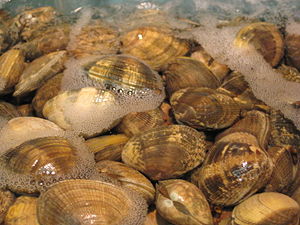Clam
Clam is an imprecisely defined common name variously used for certain bivalve mollusks or for all bivalve mollusks. As a member of the class Bivalvia (syn. Pelecypoda), clams typically are characterized by two-part calcareous shells that are hinged and more or less symmetrical and a laterally compressed muscular foot, which when extended into sediment (sand or mud), can swell with blood and form a hatchet-shaped anchor (Towle 1989). The term clam often is applied generally to those bivalves with the two shells of nearly equal size and that live in the sand or mud.
The term clam can be more precisely equated to any bivalve other than an oyster, mussel, or scallop and that has a more-and-less oval shape. In the United States, however, the word clam often means any bivalve mollusk. In this later sense, the term includes oysters, mussels, and scallops. Bunje (2001) uses the term for members of the subclass Heterodonta, but members of the order Unionoida in subclass Palaeoheterodonta often are known as freshwater clams (or as freshwater mussels).
The term clam frequently is applied to edible bivalves. Not all edible bivalves with the common name clam are round or oval in shape: the razor clam has an elongated shell whose shape suggests a straight razor.
- Food
Overview and anatomy
Clams (all bivalves) are exclusively aquatic, requiring water for reproduction and respiration, and typically for feeding (Grzimet 2003). Both marine and freshwater species are found. Shell morphology typically reflects the nature of the habitat, with calm-water species often having more delicate and leaflike shells compared to those subject to fast-flowing currents (Grzimet 2003).
A clam's shell consists of two valves, which are connected by a hinge joint and a ligament that can be external or internal. Two adductor muscles close the shells. The clam has no head, and usually has no eyes, (scallops are a notable exception), but a clam does have kidneys, a heart, a mouth, and an anus. Clams have bilateral symmetry.
Clams, like most mollusks, also have open circulatory systems, which means that their organs are surrounded by watery blood that contains nutrients and oxygen.
Bivalves tend to be filter-feeders. They lack a radula and feed by siphoning and filtering large organic matter from water, using their gills. Clams eat plankton by filter feeding, and they themselves are eaten by small sharks and squid. In the life cycle of the bivalve, the free-swimming veliger larva (characteristic of mollusks) feed on plankton before settling down.
Most hard clams live just four to eight years, but the clam species Arctica Atlantica has been known to live 200 to 300 years (Mahr 2007). In October 2007, an Arctica islandica clam caught off the coast of Iceland was discovered to be at least 405 years old,and was declared the world's oldest living animal by researchers from Bangor University.
Examples of clams
- Ark clams, family Arcidae
- Nut clams or pointed nut clams, family Nuculidae
- Duck clams or trough shells, family Mactridae
- Marsh clams, family Corbiculidae
- File clams, family Limidae
- Hard clam or Northern Quahog: Mercenaria mercenaria
- Soft clam: Mya arenaria
- Surf clam: Spisula solidissima
- Ocean quahog: Arctica islandica
- Pacific razor clam: Siliqua patula
- Giant clam: Tridacna gigas
- Asian or Asiatic clam: genus Corbicula
- Peppery furrow shell: Scrobicularia plana
- Pismo clam: Tivela stultorum (8 inch shell on display in the Pismo Beach Chamber of Commerce)
- Geoduck clam: Panopea abrupta or Panope generosa (largest burrowing clam in the world)
- Atlantic jackknife clam: Ensis directus
Culinary uses
In culinary use, the term "clam" most often refers to the hard clam Mercenaria mercenaria but it may refer to several other species such as the soft-shell clam, Mya arenaria. Clams can be eaten raw, steamed, boiled, baked or fried; the method of preparation depends partly on size and species. Clam chowder is a popular soup in the U.S. and Canada. In Italy, clams are often an ingredient of mixed seafood dishes, or are eaten together with pasta.
The Maxima clam Tridacna maxima, a species of giant clam, is popular with saltwater aquarium hobbyists.
ReferencesISBN links support NWE through referral fees
- Bunje, P. 2001. The Bivalvia: Scallops, clams, mussels, and more. University of California Museum of Paleontology. Retrieved August 9, 2008.
- Grzimek, B., D. G. Kleiman, V. Geist, and M. C. McDade. Grzimek's Animal Life Encyclopedia. Detroit: Thomson-Gale, 2004. ISBN 0307394913.
- Mahr, K. 2007. Top ten scientific discoveries. #9. The world's oldest animal. Time. Retrieved August 9, 2008.
- Russell-Hunter, W. D. 1969. A Biology of Higher Invertebrates. London: The MacMillan Company.
- Towle, A. 1989. Modern Biology. Austin, TX: Holt, Rinehart, and Winston. ISBN 0030139198.
External Links
- Deep In The Ocean A Clam That Acts Like A Plant Science Daily March 2 2007
- How to Shuck Hard Shell Clams
Credits
New World Encyclopedia writers and editors rewrote and completed the Wikipedia article in accordance with New World Encyclopedia standards. This article abides by terms of the Creative Commons CC-by-sa 3.0 License (CC-by-sa), which may be used and disseminated with proper attribution. Credit is due under the terms of this license that can reference both the New World Encyclopedia contributors and the selfless volunteer contributors of the Wikimedia Foundation. To cite this article click here for a list of acceptable citing formats.The history of earlier contributions by wikipedians is accessible to researchers here:
The history of this article since it was imported to New World Encyclopedia:
Note: Some restrictions may apply to use of individual images which are separately licensed.


